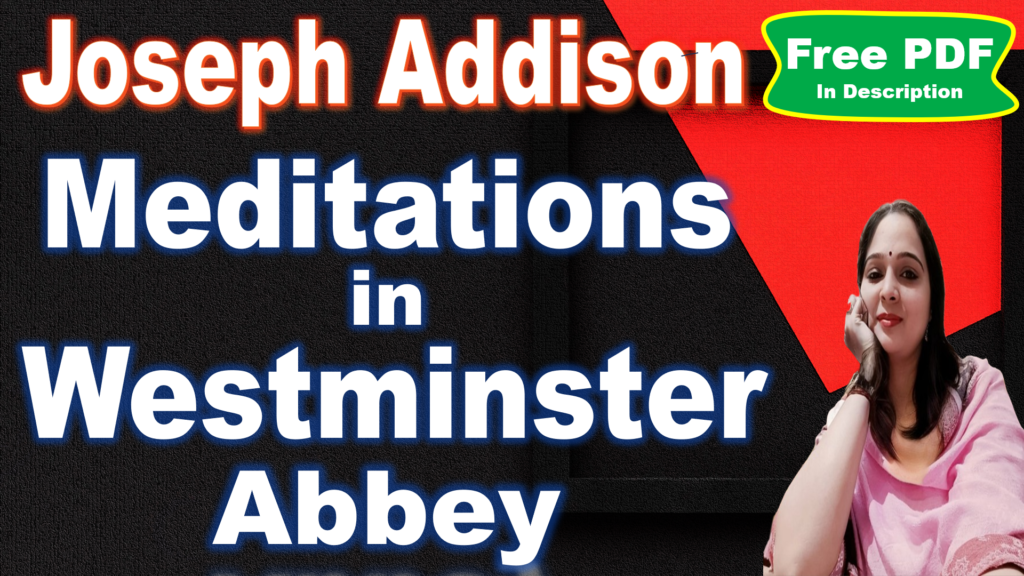
Meditations in Westminster Abbey Summary
Joseph Addison’s essay “Meditations in Westminster Abbey” was first published in the periodical “The Spectator,” which he co-founded with Richard Steele. The Spectator was a daily publication that ran from March 1, 1711, to December 20, 1712. It was known for its essays on contemporary manners, morals, and social issues, and became a significant platform for Addison’s writings. The essay was published in “The Spectator” on September 27, 1712.
In this reflective essay, Joseph Addison shares his meditations during a solitary walk-through Westminster Abbey, focusing on the theme of mortality.
Setting and Initial Thoughts: Joseph Addison describes his visit to Westminster Abbey, a place he goes to when he’s feeling serious. The dark and solemn atmosphere of the Abbey makes him think deeply about life and death, and he finds this thoughtfulness to be both interesting and not unpleasant.
Observations on Tombstones and Inscriptions: As he walks around, Addison looks at the tombstones and inscriptions in the churchyard, cloisters, and church. He notices that many of the inscriptions only mention the dates of birth and death, which makes him think these records are a bit like a joke, reducing a person’s whole life to just those two dates. He compares this to characters in epic poems who have grand names but are only remembered for their deaths.
Contemplation of Mortality: Addison reflects on the large number of people buried in the Abbey, all mixed together regardless of their status or achievements. He observes that people of all kinds—rich and poor, soldiers and priests—are now all mixed up in death, highlighting how death levels everyone out.
Analysis of Epitaphs: He looks at various epitaphs and finds some of them overly grand, which might embarrass the deceased if they could see it. Others are very modest, written in languages like Greek or Hebrew, so only a few people can understand them. Addison also notes that some poets don’t have monuments, while others do, but their works aren’t well-known.
Critique of Modern Monuments: Addison criticizes some modern monuments, especially the one for Sir Cloudesley Shovel. He thinks the monument doesn’t properly represent Shovel’s true character as a brave admiral but instead shows him as a fashionable figure. He contrasts this with Dutch monuments, which he thinks are better because they reflect the true nature of the people they commemorate.
Personal Reflection and Conclusion: Addison ends by saying that while these reflections might seem gloomy, he finds them helpful and enlightening. He doesn’t feel sad but rather thoughtful, using these reflections to overcome feelings like envy and grief. He looks forward to visiting the tombs of English kings another time and reflects on the idea that one day, everyone will be together in death, making for a great day of reckoning.
Meditations in Westminster Abbey Key Points
Author
Joseph Addison (1672–1719) was a prominent English essayist, poet, playwright, and politician. He is best known for his contributions to The Spectator, a daily publication he co-founded with Richard Steele. His writings in The Spectator are famous for their wit, elegance, and moral insights. Addison’s essays often delve into topics of society, politics, and human nature, as seen in “Meditations in Westminster Abbey.”
Introduction
“Meditations in Westminster Abbey” is an essay that reflects Addison’s thoughts on death, legacy, and the fleeting nature of life. Set in Westminster Abbey, a historic burial site for many notable figures in British history, the essay takes the reader on a reflective journey. Addison contemplates the lives of those buried there, drawing lessons on mortality and human vanity. Through his observations of tombstones, epitaphs, and monuments, Addison presents a powerful meditation on death’s ability to equalize all people, regardless of status or achievement.
Structure
The essay is structured as a personal reflection, beginning with Addison describing his frequent walks through Westminster Abbey, particularly when he is in a serious mood. It follows a chronological path, moving from Addison’s external observations of the Abbey’s tombstones and monuments to deeper internal reflections on life, death, and human nature. Addison then offers examples of specific monuments, epitaphs, and how they reflect societal values. The essay concludes with a broad, philosophical contemplation of mortality and equality in death.
Setting
The essay is set in Westminster Abbey, one of London’s most famous churches, known for being the burial place of British monarchs, poets, soldiers, and other prominent figures. Addison’s walk through the Abbey provides a serene yet somber backdrop to his reflections. The church’s architecture, history, and the presence of countless graves create an atmosphere of contemplation. The Abbey serves as a symbol of both the grandeur and the inevitable mortality that even the most famous individuals face.
Theme
Mortality and the Equality of Death: Addison explores how death unites everyone, from kings to commoners. In death, distinctions such as beauty, power, and achievement become irrelevant.
The Vanity of Human Achievements: The essay reflects on how many people’s lives are reduced to just two dates on a tombstone, with nothing else to remember them by. This serves as a reminder of the futility of worldly accomplishments and the transient nature of life.
Legacy and Memory: Addison critiques the exaggerated praise found on some epitaphs and the silence about real accomplishments in others. He questions how people will be remembered and whether inscriptions are truthful representations of their lives.
Reflection and Contemplation: Throughout the essay, Addison emphasizes the importance of reflection on death and the lessons it teaches about life. He sees value in contemplating solemn subjects to cultivate wisdom and virtue.
Style
Addison’s style in this essay is reflective, elegant, and mildly satirical. He employs a meditative tone as he walks through Westminster Abbey, blending personal experience with philosophical musings. His use of vivid imagery—such as the description of bones and skulls unearthed during grave digging—creates a poignant atmosphere. Addison’s language is refined and formal, typical of 18th-century prose, yet accessible to his readership. His gentle satire is evident in his critique of overly extravagant epitaphs and monuments, which he views as misrepresentations of people’s true characters.
Message
The central message of “Meditations in Westminster Abbey” is that death is the great equalizer. Addison suggests that no matter how important a person was in life, their legacy will likely be reduced to a simple inscription on a tombstone. He urges readers to consider the futility of worldly success and to reflect on more lasting, spiritual values. In his view, contemplating death is not a source of fear or sadness but a way to gain wisdom and humility. The essay ultimately encourages readers to live virtuous, meaningful lives that are not bound by superficial achievements.
Joseph Addison
Joseph Addison (1672–1719) was an influential English essayist, poet, and politician. He is best known for his contributions to English literature and journalism, particularly through his work with the periodical The Spectator, which he co-founded with Richard Steele. Here’s a closer look at his life and contributions:
Early Life and Education
Joseph Addison was born on May 1, 1672, in Milston, Wiltshire, England. He was educated at the Charterhouse School and then went on to study at Oxford University, where he became known for his classical education and literary talent. His academic background laid the foundation for his future literary achievements.
Literary Career
Addison’s literary career took off with his work as an essayist. He is most famous for his contributions to The Spectator, a daily publication started in 1711. The aim of The Spectator was to provide moral and intellectual reflections on contemporary society, culture, and politics. Addison’s essays in the publication were characterized by their clarity, wit, and insightful commentary.
Addison also wrote for The Tatler, another influential periodical, alongside Richard Steele. Together, these publications helped shape public opinion and intellectual life in early 18th-century England.
Major Works
“The Spectator”: Addison’s essays in The Spectator covered a wide range of topics, including manners, morals, and social issues. The work was highly influential and popular, known for its elegant prose and insightful observations.
“Cato”: Addison wrote a tragedy called Cato, which premiered in 1713. The play, set in ancient Rome, deals with themes of liberty and political virtue. It was well-received and had a significant impact on contemporary political thought.
Poetry: Addison also wrote poetry, including works such as “The Campaign,” which celebrated the Duke of Marlborough’s victories in the War of Spanish Succession.
Political Career
In addition to his literary work, Addison had a notable political career. He served as a member of Parliament and held various government positions. His political involvement was marked by his commitment to Whig principles and his support for reform.
Legacy
Joseph Addison is remembered for his significant contributions to English literature and journalism. His essays in The Spectator and The Tatler remain influential, and his writing is celebrated for its elegance, wit, and moral insight. Addison’s work helped to shape the essay genre and public discourse in his time, and he remains a key figure in the study of 18th-century literature. He died on June 17, 1719, but his legacy endures through his impactful writings.
Meditations in Westminster Abbey
Word Meaning
| Tough Word | Meaning in English | Meaning in Hindi |
| Meditations | Deep thoughts or reflections | ध्यान या चिंतन |
| Westminster Abbey | A famous church in London | लंदन का एक प्रसिद्ध चर्च |
| Gloominess | Darkness or sadness | उदासी या अंधकार |
| Solemnity | Seriousness, dignity | गंभीरता, गरिमा |
| Apt | Suitable or appropriate | उपयुक्त |
| Melancholy | A feeling of sadness | विषाद, उदासी |
| Churchyard | The yard surrounding a church, often used for burials | चर्च के चारों ओर का क्षेत्र, कब्रिस्तान |
| Cloisters | Covered walkways in a church or monastery | मठ या चर्च के गलियारे |
| Amusing | Entertaining, causing laughter | मनोरंजक |
| Tombstones | Grave markers, often made of stone | कब्र पर लगाया गया पत्थर |
| Inscriptions | Words engraved or written on a surface | शिलालेख |
| Buried | To be placed in a grave | दफनाया गया |
| Comprehended | Understood or included | समझा गया, शामिल |
| Circumstances | Conditions or facts connected with an event | परिस्थितियाँ |
| Look upon | To consider or regard | मानना, विचार करना |
| Satire | The use of humor, irony, or exaggeration to criticize | व्यंग्य |
| Heroic poems | Epic or grand poems | वीरगाथा कविताएँ |
| Knocked | To hit or strike | मारा गया |
| Holy writ | Sacred text, Bible | पवित्र शास्त्र, बाइबल |
| Grave | A burial place | कब्र |
| Shovel | A tool used for digging | फावड़ा |
| Fresh-mouldering earth | Recently decaying soil | ताज़ी सड़ती हुई मिट्टी |
| Innumerable multitudes | Countless large groups of people | अनगिनत भीड़ |
| Pavement | A hard surface or floor | फर्श या मार्ग |
| Ancient cathedral | Very old, large church | प्राचीन गिरजाघर |
| Prebendaries | Church officials | चर्च के अधिकारी |
| Crumbled | Broken into small pieces | टूट कर बिखर जाना |
| Undistinguished | Not differentiated or recognized separately | अप्रभेद्य |
| Promiscuous heap of matter | A mixed, unorganized mass of things | अनियमित ढेर |
| Lump | A mass or collection | ढेर |
| Extravagant | Excessive or elaborate | अतिशयोक्ति |
| Epitaphs | Words written on a tombstone | समाधिलेख |
| Acquainted | Familiar or aware | परिचित |
| Blush | To become red in the face due to embarrassment | शर्म से लाल हो जाना |
| Bestowed | Given as a gift or honor | प्रदान किया गया |
| Modest | Humble, simple | विनम्र, साधारण |
| Hebrew | A Semitic language | हिब्रू भाषा |
| Poetical quarter | Section related to poets | कवियों से संबंधित हिस्सा |
| Uninhabited monuments | Monuments without bodies buried there | बिना शव के स्मारक |
| Plains of Blenheim | Battlefield of the Battle of Blenheim | ब्लेन्हैम का मैदान |
| Bosom of the ocean | The depths of the ocean | समुद्र का गहराई |
| Delighted | Very pleased or happy | प्रसन्न |
| Elegance | Grace and style | सुंदरता और शैली |
| Justness | Fairness or accuracy | न्यायसंगतता |
| Conceive an idea | Form a mental image | एक विचार बनाना |
| Perusal | The act of reading or examining carefully | सावधानी से पढ़ना |
| Execution | The act of carrying out or performing something | क्रियान्वयन |
| Sir Cloudesley Shovel’s | Name of a British admiral | सर क्लाउडस्ले शॉवेल |
| Offence | Annoyance or resentment | अपमान या नाराजगी |
| English admiral | A naval officer of the British navy | ब्रिटिश नौसेना का अधिकारी |
| Gallant man | Brave and heroic man | बहादुर और वीर पुरुष |
| Beau | A fashionable, elegant man | फैशनेबल पुरुष |
| Periwig | A wig worn during the 17th century | 17वीं सदी का विग |
| Canopy of state | A decorative cover over a throne | शाही छत्र |
| Acquaints | Makes familiar or aware | परिचित कराना |
| Reap | To receive or gain something | प्राप्त करना |
| Despise | To regard with contempt | तिरस्कार करना |
| Antiquity | Ancient times | प्राचीनता |
| Erected | Built or constructed | बनाया गया |
| Public expense | At the cost of the government | सार्वजनिक खर्च |
| Adorned | Decorated or embellished | सजाया गया |
| Rostral crowns | Crowns shaped like the front of a ship | जहाज की नोक के आकार के ताज |
| Naval ornaments | Decorations related to ships or the navy | नौसेना से संबंधित सजावट |
| Festoons | Decorative chains or garlands | माला या सजावटी श्रृंखला |
| Seaweed | Marine plants | समुद्री पौधे |
| Shells | Hard outer covering of marine animals | समुद्री जीवों के खोल |
| Coral | Marine invertebrates’ skeleton | मूंगे की संरचना |
| Repository | A place where things are stored | भंडार |
| English kings | British monarchs | अंग्रेजी राजा |
| Contemplation | Deep thought | चिंतन, मनन |
| Disposed | Inclined or willing | इच्छुक |
| Dismal | Depressing or gloomy | उदास |
| Timorous | Fearful or nervous | भयभीत |
| Gloomy | Dark or depressing | उदास |
| Solemn | Serious or grave | गंभीर |
| Gay | Cheerful or joyful | खुशहाल |
| Envy | Jealousy or resentment | ईर्ष्या |
| Inordinate | Excessive or beyond normal bounds | अत्यधिक |
| Grief | Deep sorrow | गहरा दुख |
| Compassion | Sympathy or concern | सहानुभूति |
| Vanity of grieving | Pointlessness of mourning | शोक की व्यर्थता |
| Deposed | Removed from power | सत्ता से हटा दिया गया |
| Rival wits | Competing intellects | प्रतिद्वंद्वी बुद्धिजीवी |
| Contests and disputes | Arguments or competitions | बहस और झगड़े |
| Astonishment | Great surprise | आश्चर्य |
| Factions | Small conflicting groups | गुट |
| Contemporaries | People living at the same time | समकालीन लोग |





